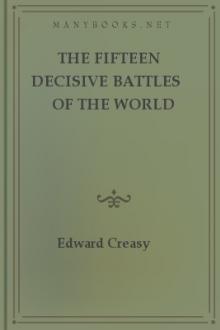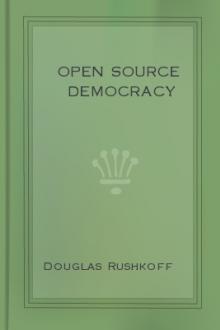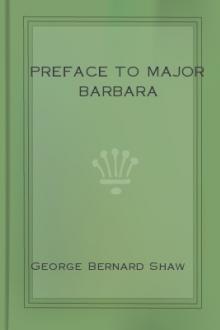The Fifteen Decisive Battles of the World from Marathon to Waterloo, Edward Creasy [simple e reader TXT] 📗

- Author: Edward Creasy
- Performer: -
Book online «The Fifteen Decisive Battles of the World from Marathon to Waterloo, Edward Creasy [simple e reader TXT] 📗». Author Edward Creasy
“Terrific was his semblance, in no mould Of beautiful proportion cast; his limbs Nothing exalted, but with sinews braced Of Chalybaean temper, agile, lithe,
And swifter than the roe; his ample chest Was overbrowed by a gigantic head, With eyes keen, deeply sunk, and small, that gleam’d Strangely in wrath, as though some spirit unclean Within that corporal tenement installed Look’d from its windows, but with temper’d fire Beam’d mildly on the unresisting. Thin His beard and hoary; his flat nostrils crown’d A cicatrised, swart visage,—but withal That questionable shape such glory wore That mortals quail’d beneath him.”Two chiefs of the Franks, who were then settled on the lower Rhine, were at this period engaged in a feud with each other: and while one of them appealed to the Romans for aid, the other invoked the assistance and protection of the Huns. Attila thus obtained an ally whose co-operation secured for him the passage of the Rhine; and it was this circumstance which caused him to take a northward route from Hungary for his attack upon Gaul.
The muster of the Hunnish hosts was swollen by warriors of every tribe that they had subjugated; nor is there any reason to suspect the old chroniclers of wilful exaggeration in estimating Attila’s army at seven hundred thousand strong. Having crossed the Rhine, probably a little below Coblentz, he defeated the King of the Burgundians, who endeavoured to bar his progress. He then divided his vast forces into two armies,—one of which marched north-west upon Tongres and Arras, and the other cities of that part of France; while the main body, under Attila himself marched up the Moselle, and destroyed Besancon, and other towns in the country of the Burgundians. One of the latest and best biographers of Attila well observes, that, “having thus conquered the eastern part of France, Attila prepared for an invasion of the West Gothic territories beyond the Loire. He marched upon Orleans, where he intended to force the passage of that river; and only a little attention is requisite to enable us to perceive that he proceeded on a systematic plan: he had his right wing on the north, for the protection of his Frank allies; his left wing on the south, for the purpose of preventing the Burgundians from rallying, and of menacing the passes of the Alps from Italy; and he led his centre towards the chief object of the campaign—the conquest of Orleans, and an easy passage into the West Gothic dominion. The whole plan is very like that of the allied powers in 1814, with this difference, that their left wing entered France through the defiles of the Jura, in the direction of Lyons, and that the military object of the campaign was the capture of Paris.” [Biographical Dictionary commenced by the Useful Knowledge Society in 1844.]
It was not until the year 451 that the Huns commenced the siege of Orleans; and during their campaign in Eastern Gaul, the Roman general Aetius had strenuously exerted himself in collecting and organizing such an army as might, when united to the soldiery of the Visigoths, be fit to face the Huns in the field. He enlisted every subject of the Roman empire whom patriotism, courage, or compulsion could collect beneath the standards; and round these troops, which assumed the once proud title of the legions of Rome, he arrayed the large forces of barbaric auxiliaries whom pay, persuasion, or the general hate and dread of the Huns, brought to the camp of the last of the Roman generals. King Theodoric exerted himself with equal energy, Orleans resisted her besiegers bravely as in after times. The passage of the Loire was skilfully defended against the Huns; and Aetius and Theodoric, after much manoeuvring and difficulty, effected a junction of their armies to the south of that important river.
On the advance of the allies upon Orleans, Attila instantly broke up the siege of that city, and retreated towards the Marne. He did not choose to risk a decisive battle with only the central corps of his army against the combined power of his enemies; and he therefore fell back upon his base of operations; calling in his wings from Arras and Besancon, and concentrating the whole of the Hunnish forces on the vast plains of Chalons-sur-Marne. A glance at the map will show how scientifically this place was chosen by the Hunnish general, as the point for his scattered forces to converge upon; and the nature of the ground was eminently favourable for the operations of cavalry, the arm in which Attila’s strength peculiarly lay.
It was during the retreat from Orleans that a Christian is reported to have approached the Hunnish king, and said to him, “Thou art the Scourge of God for the chastisement of Christians.”
Attila instantly assumed this new title of terror, which thenceforth became the appellation by which he was most widely and most fearfully known.
The confederate armies of Romans and Visigoths at last met their great adversary, face to face, on the ample battle-ground of the Chalons plains. Aetius commanded on the right of the allies; King Theodoric on the left; and Sangipan, king of the Alans, whose fidelity was suspected, was placed purposely in the centre and in the very front of the battle. Attila commanded his centre in person, at the head of his own countrymen, while the Ostrogoths, the Gepidae, and the other subject allies of the Huns, were drawn up on the wings. Some manoeuvring appears to have occurred before the engagement, in which Attila had the advantage, inasmuch as he succeeded in occupying a sloping hill, which commanded the left flank of the Huns. Attila saw the importance of the position taken by Aetius on the high ground, and commenced the battle by a furious attack on this part of the Roman line, in which he seems to have detached some of his best troops from his centre to aid his left. The Romans having the advantage of the ground, repulsed the Huns, and while the allies gained this advantage on their right, their left, under King Theodoric, assailed the Ostrogoths, who formed the right of Attila’s army. The gallant king was himself struck down by a javelin, as he rode onward at the head of his men, and his own cavalry charging over him trampled him to death in the confusion.
But the Visigoths, infuriated, not dispirited, by their monarch’s fall, routed the enemies opposed to them, and then wheeled upon the flank of the Hunnish centre, which had been engaged in a sanguinary and indecisive contest with the Alans.
In this peril Attila made his centre fall back upon his camp; and when the shelter of its entrenchments and waggons had once been gained, the Hunnish archers repulsed, without difficulty, the charges of the vengeful Gothic cavalry. Aetius had not pressed the advantage which he gained on his side of the field, and when night fell over the wild scene of havoc, Attila’s left was still unbroken, but his right had been routed, and his centre forced back upon his camp.
Expecting an assault on the morrow, Attila stationed his best archers in front of the cars and waggons, which were drawn up as a fortification along his lines, and made every preparation for a desperate resistance. But the “Scourge of God” resolved that no man should boast of the honour of having either captured or slain him; and he caused to be raised in the centre of his encampment a huge pyramid of the wooden saddles of his cavalry: round it he heaped the spoils and the wealth that he had won; on it he stationed his wives who had accompanied him in the campaign; and on the summit he placed himself, ready to perish in the flames, and baulk the victorious foe of their choicest booty, should they succeed in storming his defences.
But when the morning broke, and revealed the extent of the carnage, with which the plains were heaped for miles, the successful allies saw also and respected the resolute attitude of their antagonist. Neither were any measures taken to blockade him in his camp, and so to extort by famine that submission which it was too plainly perilous to enforce with the sword. Attila was allowed to march back the remnants of his army without molestation, and even with the semblance of success.
It is probable that the crafty Aetius was unwilling to be too victorious. He dreaded the glory which his allies the Visigoths had acquired; and feared that Rome might find a second Alaric in Prince Thorismund, who had signalized himself in the battle, and had been chosen on the field to succeed his father Theodoric. He persuaded the young king to return at once to his capital: and thus relieved himself at the same time of the presence of a dangerous friend, as well as of a formidable though beaten foe.
Attila’s attacks on the Western, empire were soon renewed; but never with such peril to the civilized world as had menaced it before his defeat at Chalons. And on his death, two years after that battle, the vast empire which his genius had founded was soon dissevered by the successful revolts of the subject nations.
The name of the Huns ceased for some centuries to inspire terror in Western Europe, and their ascendency passed away with the life of the great king by whom it had been so fearfully augmented.
[If I seem to have given fewer of the details of the battle itself than its importance would warrant, my excuse must be, that Gibbon has enriched our language with a description of it, too long for quotation and too splendid for rivalry. I have not, however, taken altogether the same view of it that he has. The notes to Mr. Herbert’s poem of “Attila” bring together nearly all the authorities on the subject.]
SYNOPSIS OF EVENTS BETWEEN THE BATTLE OF CHALONS, A.D. 451, AND
THE BATTLE OF TOURS, 732.
A.D. 476. The Roman Empire of the West extinguished by Odoacer.
482. Establishment of the French monarchy in Gaul by Clovis.
455-482. The Saxons, Angles, and Frisians conquer Britain except the northern parts, and the districts along the west coast. The German conquerors found eight independent kingdoms.
533-568. The generals of Justinian, the Emperor of Constantinople, conquer Italy and North Africa; and these countries are for a short time annexed to the Roman Empire of the East.
568-570. The Lombards conquer great part of Italy.
570-627. The wars between the Emperors of Constantinople and the Kings of Persia are actively continued.
622. The Mahometan era of the Hegira. Mahomet is driven from Mecca, and is received as prince of Medina.
629-632. Mahomet conquers Arabia.
632-651.





Comments (0)